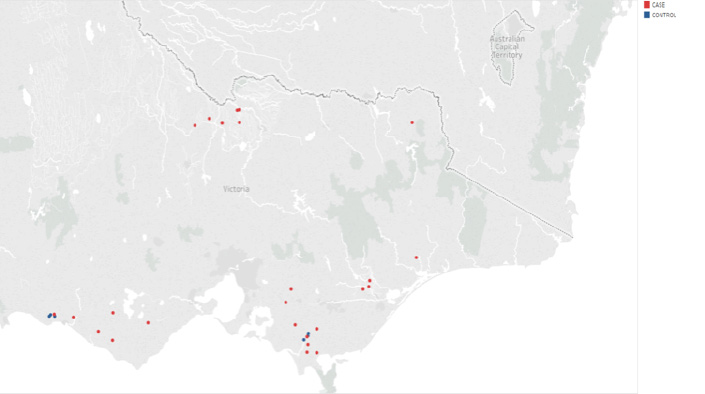Upper alimentary ulcerative syndrome (UAUS) project update — year one
In 2013, the pathology group at AgriBio (Bundoora, Victoria) identified a previously unrecognised syndrome of upper alimentary tract ulceration and enteritis in weaned dairy calves for which no aetiological agent could be identified.
Calves presented with wasting, diarrhoea and ulcerative oesophagitis and pharyngitis.
The project, which began in October 2016 and is funded until 2019, is a case-control study.
The objectives of the study are to:
- contribute further evidence towards an accurate case definition for acute UAUS
- evaluate herd and animal-level risk factors for acute UAUS
- estimate the relative incidence of acute UAUS in Victorian dairy herds
- estimate the herd-level incidence of other causes of post-weaning diarrhoea, weight loss or oral/nasal ulceration in Victorian dairy herds
- provide appropriate samples for investigation of potential causative agents of UAUS
Eligible case herds
Victorian dairy herds containing more than five weaned dairy calves (up to 8 months of age) with diarrhoea or weight loss (with or without concurrent mortality)
or
Victorian dairy herds containing one or more weaned dairy calves with oral or nasal ulceration
Results
Between October 2016 and 14 November 2017, 26 case herds and 5 control herds were included in the study.
Herds were located across the three main dairying areas in Victoria (there were 2 beef calves submitted).

Faecal samples were tested for internal parasites, yersinia and salmonella. Blood samples were tested for BVDV and oral swabs were tested for bovine papular stomatitis virus and infectious bovine rhinotracheitis. Where indicated, samples were sent to AAHL for FMD and vesicular stomatitis exclusion testing.
Of the case herds, nine were identified with lesions consistent with UAUS and nine were found to be negative. Eight herds remain suspect. Confirmed UAUS herds were found in all three regions (Figure 2).
Producer surveys
Twenty-four producers have returned surveys. 18 were from case herds (one was not completed) and six were from control herds. Producers who completed the survey were eligible to go in the draw for two gift vouchers.
The first draw was conducted at the end of November with gift cards sent to two lucky winners, one from the Goulburn Valley and the other from south-west Victoria.

Figure 2. Location of case herds in Victoria, with colour differentiating UAUS herd status
Alt: Map of Victoria showing the location of 7 investigations (2 confirmed UAUS, 3 negative and 1 suspect) in northern dairy region, 6 investigations (2 confirmed UAUS, 2 suspect and 2 negative) in the south-west and 12 investigations (4 confirmed, 4 suspect and 4 negative) in the south-east dairy region.
At least one suspect case herd was submitted each month between November 2016 and August 2017, with UAUS-positive herds predominantly diagnosed from February 2017.

Causes of disease in UAUS negative case herds included salmonella, bovine papular stomatitis, internal parasites, ulcerative gingivitis.
Suspect cases typically had no other cause identified but had also not submitted the required tissue samples to permit exclusion of UAUS.
Note: Early results indicate that this condition cannot be distinguished based on clinical signs alone from other causes of post-weaning weight loss and scours in dairy calves. Adequate post-mortem samples are required to definitively diagnose UAUS.
There are a number of important changes to the project for future seasons.
1. Sampling requirements
Case herds (sample up to 5 sick (clinical) and up to 5 healthy calves).
Collect the following:
- 20 grams of fresh faeces from rectum
- Swab of the faeces collected above and placed in VTM
- Swab of any oral or nasal ulcers. Vigorously rub the affected area to ensure sufficient material is collected. If there are no obvious ulcers, take a swab of the underside of the tongue. Store and add to VTM in same way as faecal swab.
- 10 ml whole blood (EDTA samples is no longer required)
Necropsied calves
If a calf is necropsied, samples from the upper alimentary tract, in particular the oesophagus, must be included. These samples are critical for diagnosis and no post-mortem payment will apply if these samples are not collected.
2. Study survey — Additional compensation available for veterinarians
It is essential that the farmer fully completes the study survey. To maximise the likelihood that this will be completed for every study herd, the veterinarian is asked to spend 30 to 60 minutes with the farmer ensuring the survey is completed and returned to researchers.
New compensation amounts
| Private veterinarian | Amount |
|---|---|
Per case herd: Sampling by private vet of clinical and non-clinical heifers (inclusive of materials) | $400 (GST included) |
Additional fee for completing one post mortem Note: Samples from the upper alimentary tract, in particular the oesophagus, must be included. | $300 (GST included) |
Completion of study survey with the farmer | $300 (GST included) |
Producer | Amount |
Calf euthanasia Each herd owner/manager should be provided with a compensation form on the day of sampling (one copy per sample pack) to be sent back to the address below. | $300 (GST included) |